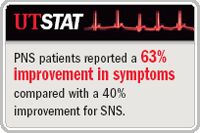Article
Pudendal neurostimulation may be alternative to SNS
Atlanta-Stimulation of the pudendal nerve may be an alternative to sacral neurostimulation (SNS) in the treatment of urinary voiding dysfunction. Two recent studies at William Beaumont Hospital in Royal Oak, MI, indicate that pudendal neurostimulation (PNS) significantly improves cystometric parameters and is effective in patients who do not respond to sacral nerve stimulation.

"Neuromodulation has been a major advance in the management of voiding dysfunction," said Kenneth Peters, MD, director of research, department of urology, at WBH. "But not all patients respond to sacral nerve therapy."

In a trial with 10 patients who had failed SNS using the InterStim device (Medtronic, Minneapolis), PNS produced significant improvement, Dr. Peters reported. In this randomized, crossover trial, patients had a second tined InterStim lead placed at the pudendal nerve via a posterior approach. Both the pudendal and sacral leads were externalized. Each lead was tested for 7 days on a blinded schedule while patients maintained voiding diaries and completed questionnaires. Nine patients had refractory urgency/frequency (seven women, two men) and one patient had female idiopathic urinary retention.
Eight patients (80%) responded and were implanted. Six patients (60%) chose PNS; two patents (20%) opted for SNS. Of the six who chose PNS, four (66%) responded only to pudendal treatment, and two (33%) responded better to pudendal stimulation than to sacral. The two patients who chose sacral treatment reported 50% improvement to both pudendal and sacral stimulation.
PNS patients reported a 63% improvement in symptoms compared with a 40% improvement for SNS. The patient who had female idiopathic urinary retention had no response to SNS, but was able to stop intermittent self-catheterization after PNS therapy.
Patients in the pudendal group reported that the number of voids fell from 35 per day at baseline to 19 per day at 6 months, a 45% improvement. Mean voided volume increased by 54%, from 84 cc to 130 cc. Two patients who received sacral implants saw voids decrease from 22 per day to 12, a 46% decline, and an increase in void volume of 50%, from 85 cc to 127 cc.
In a second study, Dr. Peters examined another possibility for pudendal stimulation known as the bion (Advanced Bionics, Santa Clarita, CA), a leadless, implantable microstimulator that is currently in multicenter trials. Because the device has no external lead, patients undergo an office test to determine if they could benefit from a permanent implant.
In that test, a stimulating needle is inserted under local anesthetic through the perineum toward the ischial spine. Electrical current is delivered through the needle. The pudendal nerve is confirmed by measuring complex muscle action potentials and by monitoring sensory and motor responses. Baseline cystometric volumes are compared before and after stimulation.
Dr. Peters reported on 22 patients with refractory voiding dysfunction whose pudendal nerve was stimulated for 15 minutes.Based on a 50% increase in first urge to void, volume until uninhibited bladder contraction, or maximum cystometric capacity, 19 patients qualified for a permanent implant.
Patients are currently in follow-up so long-term efficacy of the implanted pudendal nerve stimulator can be tracked. Data will be submitted for FDA approval in the future.
"Pudendal stimulation will be a new avenue to treat patients with voiding dysfunction," Dr. Peters said. "At least in the short term, I would like this to be an alternative to sacral stimulation. These patients are in a desperate situation."
Dr. Peters is a consultant for Medtronic and Advanced Bionics.




